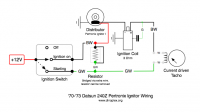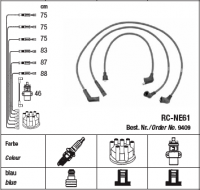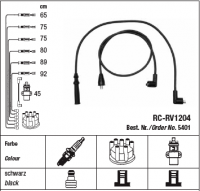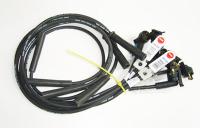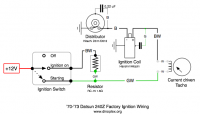Everything posted by alhbln
-
HI-6 not recieving trigger signal from Unilite
The unilite distributor has an optical switch but acts like a points or transistor setup to the outside. The green wire supplies the ground signal for the coil, so for triggering the Hi-6 you connect the green wire of the Unilite distributor to the white wire (points input) of the Hi-6 unit (which you probably did already). It appears that either the Unilite distributor is not getting +12 volt via the red wire and ground via the brown wire, or the Unilite module in the distributor is defective. While the ignition is switched on, measure the red against the brown wire with a multimeter to make sure that the Unilite receives power (+12V). If this turns out ok, connect a small bulb (4 or 21 watt standard car bulb) or a test light to battery (+) or red and the green wire. It should flash when you turn the distributor or try to start the car. You should also be able to trigger an ignition by introducing a piece of cardboard inside the optical switch, when removing the cardboard you should get a spark from the Hi-6.
-
What's Grounding Here?
From what i have seen so far, the four wire tach was replaced by the three wire tach in the last 240Z's which have been build (series 4, '73), the 260Z then came with the three wire tach as default.
-
Pertronix Ignitor 1761 install and coil evaluation
Here is the wiring setup for the Pertronix conversion. I have no experience converting a distributor for an automatic 240Z so maybe someone who did this can chime in.
-
My dual exhaust build
Very nice, congrats, good job!
-
Pertronix Ignitor 1761 install and coil evaluation
The issues with your advance setting sound like sticky advance weights which do not extend all the way (or not at all in the worst case). If the exhaust knock took place in overrun, then your vacuum advance might be sticky or there is a problem with the vacuum supply. A timing light is always a good thing to have at hand, i wonder why there are no timing marks on your engine, though.
-
tach problem
Try to measure the overal resistance, should be not less than ~2-2.5KΩ. Not sure if directly connecting the tacho to the coil is healthy, get hold of a 1,5K and 1K resistor and try those instead of the existing inline 2.2KΩ resistor.
-
tach problem
Good chance the kickback signal is too weak and the tach is actually working. Check out the line resistor as described in zKars posting and measure the resistance of the tach to coil wire (disconnect the tacho and measure from the dashboard connector to the coil negative terminal).
- tach problem
-
sourcing electrical upgrade parts
It might work to wire in two parallel relays for the fuel pump, one is activated (deactivated) by the oil pressure switch (or better a oil pressure fuel cutout switch which is more sensitive), the second one by the starter solenoid wire. In an ideal world you would have also a timer which activates the fuel pump for 2-4 seconds after ignition is switched on to build up the initial pressure in the fuel system. A simpler solution might be to integrate an inertia switch (fuel pump shut off switch), which deactives the fuel pump on impact. You can get those switches at race equipment stores, retrofitting them to a car is quite straightforward. http://www.smartracingproducts.com/catalog/electrical.htm http://www.pegasusautoracing.com/productdetails.asp?RecId=87
-
tach problem
The chart from 74L28Z is the right one. The 260 has a kickback driven tach (three wire tach), where one wire of the tach goes to the coil's negative terminal. Previous tachs for the 240Z were current driven tachs (four wire tachs) where the coil current is routed through a wire loop at the back of the tach. From the wiring i would assume that the color of the tacho's wire going to the negative coil terminal is black. The wire coming out of the tach going to the dashboard wiring connector is yellow. You might want to do a continuity check with a multimeter from the three terminal dashboard wiring connector to the wires at your coil to make sure the wire is ok and you got the right one. Do you have the factory ignition or a modified system? Can you post a photo showing your coil wiring? Both the four wire as well as the three wire tach can be repaired in most cases, after a repair and calibration they are still quite good and not as unreliable as one may think. My '72 tach is quite on the point with a maximum error rate of 4% after calibration.
- put the Z in Twilight Zone
-
1976 ecm
From memory, the unit with the missing terminals won't work as a replacement as the sensor input wiring for the air flow meter switch and cold start valve is handled differently. You won't fry anything but the car won't start, so you might give it a try to check what happens.
-
GM hei Tach issues
Which tach do you have installed, the four wire (current driven) or the later three wire (kickback drive) type? Do you use a ballast resistor with the Blaster coil? A 5K limit sounds like the four wire type which is not getting a strong signal due to the lower coil current in higher rpms. A possible fix could be to recalibrate the tach using the trimmer which is accessible through the taped hole the back (use an insulated or plastic screwdriver). The trimmer changes the sensivity of the input stage. Regarding the precision of the old 240Z tach, i added an additional driver board to my four wire tach to connect to a mapped ignition, and after a recalibration the tach is now quite on the point, with a maximum error rate of +3-4% between 3K-6K. Not too bad for an 38 year old tach.
-
Pertronix or Crane XR-700?
Nothing practical except an illuminated "ignition on" toggle switch on the dashboard, racecar style. (Silly, i know). The problem only arises when the Pertronix switches current to the coil, so it depends on the actual position of the trigger ring in the distributor if your Ignitor is toasted after some time when the ignition is switched on. You won't have this problem if you use the Pertronix Ignitor to trigger another ignition thogh (MSD 6A, Crane Hi6 etc), the current flowing through the Ignitor in such a setup is quite small.
-
Pertronix or Crane XR-700?
From an engineers perspective i would recommend the XR-700, the power unit has its own, well cooled enclosure and the output stage is more powerful than the Pertronix Ignitor I. Also the power circuit is separated from the distributor/trigger, which is good engineering. Another plus to me is that the Crane XR-700 setup can be easily repaired if ever required whereas the Pertronix Ignitor is potted, and can only be replaced if it should break. Both units control dwell based on the static trigger gap (optical, magnet distance), there is no variable dwell, which is a good thing to have. You might want to consider to have a look at the slightly more expensive XR-3000, which has variable dwell control as well as adaptive coil current to avoid coil saturation. There is no functional difference in using a hall trigger (Pertronix) compared to an optical trigger (Crane). That Pertronix did not add current control to the Ignitor I (e.g. no burning out of the output stage if the ignition is switched on for a longer time) seems to be marketing related to have an extra feature for the more expensive Ignitor II and III units. Current control only adds cents in the production stage and is standard with most HEI, Bosch and Marelli transistor modules since decades.
-
NGK spark plug wires
The blue NGK spark cable set which is offered for the 240Z by many dealers is actually the OEM RC-NE61 set for the Datsun 280ZX. The cable color is based on the market, nowadays NGK's OEM sets for japanese manufacturers (such as Mazda) are blue, but single wires or european OEM sets are black. If you download the cable catalogue as a PDF from NGKs website, you can combine your own set of wires based on the cable type list. (If you want to go for straight copper cables you need to use resistor plugs, such as BPR6ES). I did a set based on the cable catalogue so i could have the historical correct black NGK spark cables with EDIS connectors for my Megajolt setup. If you don't mind the slightly different spark plug connectors, you could also go with the NGK RC-RV1204 black cable set.
-
I'm new... Driving problems etc HELP!
Checking the plugs immediately after the engine died would be good to see if its fuel related (plugs are dry) or ignition related (plugs are wet). Maybe you could repeat the test on your driveway?
-
Electrical odyssey about to begin!
I would like to add that next to 1. a test light and 2. a decent multimeter (spend at $20-$40 for a good one you don't need a specific automotive multimeter which is more expensive), the third most important 'tool' is contact spray (or spray contact cleaner). Source a can of "Kontakt 60" spray and apply it to contacts, wire ends and plugs to get rid of oxidation and contact problems. Always work from one end to the other and take photos and write down measured values. Get into a habit to draw circuit diagrams of what you check and discover, this helps tremendously in understanding how your car's electric setup works. The Haynes Practical Electrical Manual is a good start for a beginner to understand whats going on. Also, source PDF downloads of the electrical manuals for your car, print them out and add comments to them while you work on the car.
-
I'm new... Driving problems etc HELP!
I still think this is related to fuel starvation, an electrical problem with the ignition would also have an impact while you just rev the engine without load, but that apparently worked. Lets do another test to check the distributor. What happens if you unplug the vacuum tube to the distributor, does the engine still die on load (driving)? Can you do another drive test and when the engine dies, immediately remove the plugs (e.g. don't start again) and post a photo how they look like?
-
I'm new... Driving problems etc HELP!
You can rev the engine until the mph limit in first gear, so i would assume that the ignition and advance plate/vacuum is ok. Sounds like fuel starvation to me. What happens when you rev the engine without being in a gear, can you rev it up to 3000-4000 RPM or does it die then too?
-
Resistor is heating up and I don't know why?
Assuming that you have a points setup' date=' it sounds ike your coil's (-) terminal is permanently connected to ground. You should have two wires going to the coil, a black/white wire to coil (+), and a black wire to coil (-). Check out where the black wire from coil (-) is connected to, with a factory points setup it should be going to the distributor's spade terminal (the spade terminal is mounted on a white plastic block on the distributor body, above the condenser): [list'] [*]If the black wire is not wired to the spade terminal, you need to fix the wiring as shown below in the circuit diagram [*]If the black wire is connected to the distributor body, you need to make sure that the points setup is ok and that the black wire with the yellow ring inside the distributor (connecting the spade terminal to the breaker contact) does not touch ground. You might also check the capacitor, if its broken there is a small chance it short wired the spade terminal permanently to ground.
-
Resistor is heating up and I don't know why?
Do you have the factory wiring/points setup or an upgraded ignition? Does the car start at all? When does the coil/resistor heat up, only in the staring position, or also when you just switch on the ignition without starting? The coil/resistor heats up considerably when the points setup is broken (points are always connected, points wire has ground contact). If the wiring is wrong (ground connected to coil (-)), then you would have the same effect.
-
I'm new... Driving problems etc HELP!
Looks like he has a Pertronix Ignitor I distributor conversion, you can see the red and black silicone wires coming from the distributor.
-
76 280z feul pump and injectors no power
The injector resistors are documented on page 6 of the 280-Z EFI troubleshooting guide. I highly recommend that you spend some time with this document as it thoroughly explains the EFI setup and troubleshooting procedures. The resistors rarely break though, i would start with the relay diagnosis on page 63-68.
-
I'm new... Driving problems etc HELP!
Electronic ignitions usually replace the breaker against an electronic trigger setup but you still have the advance weights and vacuum mechanism. Which electronic ignition is installed in your car?





